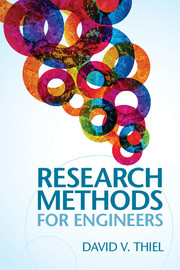Book contents
- Frontmatter
- Contents
- Preface
- An introductory note for instructors
- 1 Introduction to engineering research
- 2 Literature search and review
- 3 Developing a research plan
- 4 Statistical analysis
- 5 Optimization techniques
- 6 Survey research methods
- 7 Research presentation
- 8 The path forward
- Appendix A: Matlab plot functions
- Appendix B: Excel plot functions
- Index
- References
6 - Survey research methods
Published online by Cambridge University Press: 05 September 2014
- Frontmatter
- Contents
- Preface
- An introductory note for instructors
- 1 Introduction to engineering research
- 2 Literature search and review
- 3 Developing a research plan
- 4 Statistical analysis
- 5 Optimization techniques
- 6 Survey research methods
- 7 Research presentation
- 8 The path forward
- Appendix A: Matlab plot functions
- Appendix B: Excel plot functions
- Index
- References
Summary
Why undertake a survey?
Engineering research only has value when it directly or indirectly contributes to the improvement of the human condition. One form of research is to seek information about and/or feedback from people about the outcomes or the proposed outcomes of the research, whether this is a product or a service. In addition, an assessment of the ‘usability’ of a product or service can be the subject of a research programme [1]. A failure to consult the potential users of developing technology may restrict its use in society. For example, the developer of new technology should recognize and address the limitations of that technology by addressing the following questions:
Is the technology limited to a particular age group, ethnic group, or a group with disabilities – mental and physical?
Will the technology cause unintentional harm to users and the environment?
Is it possible that the technology can cause injury, disability and even death in the very worst cases?
One method of reviewing these questions is to seek feedback from the potential users and the public at large. In many countries, anti-discrimination laws restrict the design and use of community infrastructure which is not inclusive of sections of the population with disabilities.
- Type
- Chapter
- Information
- Research Methods for Engineers , pp. 192 - 229Publisher: Cambridge University PressPrint publication year: 2014



